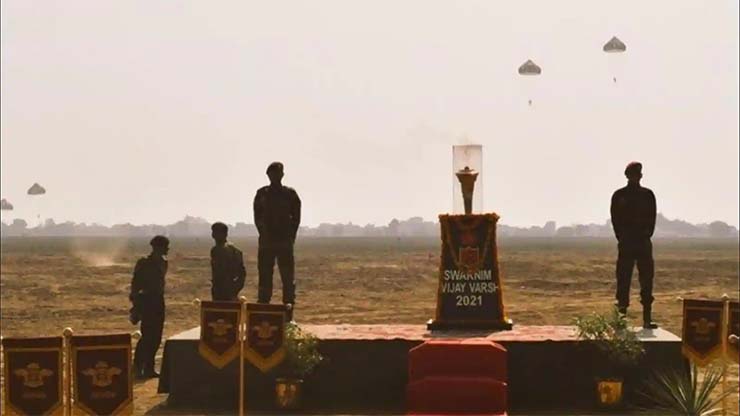
New Delhi: At a function in Agra, a general of the Indian Army led a mass parachute jump to mark 50 years of the historic battalion-sized Tangail airdrop north of Dhaka during the 1971 war with Pakistan and as a tribute to the nation’s first Chief of Defence Staff General Bipin Rawat who along with his wife and twelve others met a tragic end in a helicopter crash in Coonoor, Tamil Nadu on December 8.
The Tangail airdrop which was one of the biggest airborne operation ever mounted by Indian paratroopers was a virtual turning point in the 1971 Indo-Pakistan war as it set the stage for surrender by the rival army, sources said.
Central Army commander Lieutenant General Yogendra Dimri led the mass jump involving 120 elite paratroopers and four veterans who took part in the 1971 India-Pakistan war.
“General Rawat envisioned jointmanship amongst the services to touch the highest standards of integration and execution. The parachute jump was marked by precise coordination between the army and air force in the best spirit of jointmanship,” the Indian Army said in a statement.
The aim of the Tangail operation was to capture the Poongli Bridge on Jamalpur-Tangail-Dhaka road and the ferry site on Louhajang River to intercept Pakistan army’s 93 Brigade that was retreating from the north to defend Dhaka, the officials said.
Around 750 men of the 2nd Battalion of the Parachute Regiment were involved in the successful mission. The paratroopers defeated a force that was three times numerically superior and shattered the will of the Pakistani army to defend Dhaka.
Several veterans who took part in the Tangail airdrop and the subsequent operations in Bangladesh witnessed the commemoration of the landmark event at Agra. Lieutenant General Nirbhay Sharma, who was the adjutant of 2 Para during the 1971 war, was among those present.
The veterans who took part in the mass jump were Lieutenant General RR Goswami, Major General Shiv Jaswal, Colonel Thomas Kochappan and Colonel Pramod Tembe.
The Shatrujeet airborne brigade, consisting of the army’s finest paratroopers and based at Agra, was the centrepiece of high-altitude combat manoeuvres carried out by the army and the air force in the Ladakh sector in early November.
The airborne drills in eastern Ladakh aimed to validate and showcase the Indian military’s rapid response capabilities, including inter-theatre movement of troops and equipment, precision stand-off drops, rapid grouping and ability to capture designated targets with speed and surprise at a time when India and China are locked in a standoff along the Line of Actual Control (LAC) in the sensitive sector.
Other elements of the exercise include integrated battle drills by airborne forces, mechanised columns and attack helicopters.









